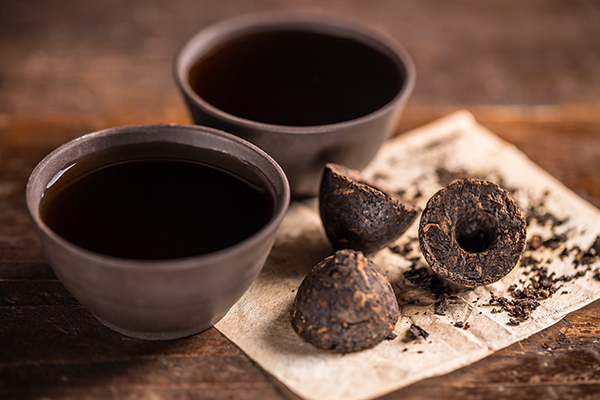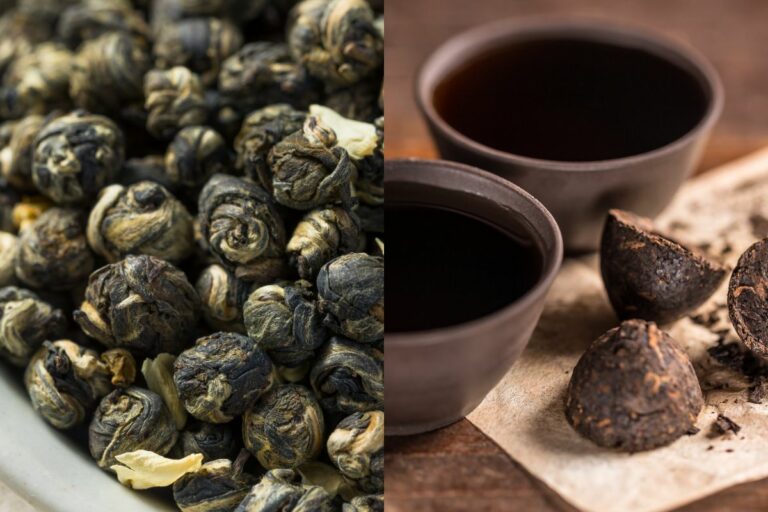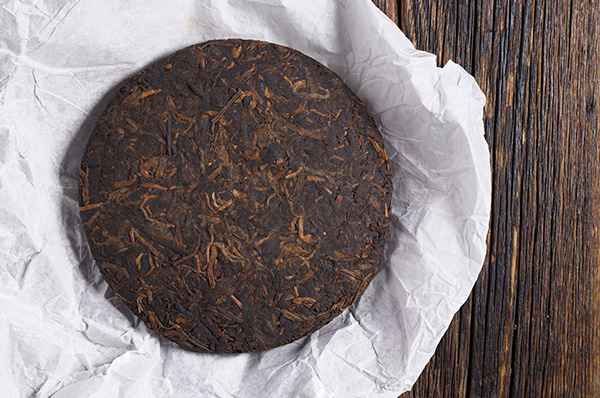Pu-Erh Tea 101: Benefits, Side Effects, and More
While pu-erh tea has been a staple in Chinese culture for centuries, it’s increasingly gaining popularity across the globe.
This comprehensive guide will explore the unique attributes of pu-erh tea, from its potential health benefits and side effects to its preparation methods.

What Is Pu-Erh Tea?
Pu-erh tea, pronounced as ‘poo-air’, is a unique variety of fermented tea originally cultivated in the Yunnan province of China. This tea undergoes a unique post-fermentation process, which allows the tea leaves to mature over time, leading to its characteristic deep, robust flavor and dark color. Often likened to a fine wine, the value of pu-erh tea can increase with age.
Potential Health Benefits of Pu-Erh Tea
Pu-erh tea has a few potential health benefits, from aiding weight loss to supporting heart health.
Aids in Weight Loss
Research suggests that pu-erh tea could potentially aid in weight loss. The tea is believed to help increase metabolism, enhance the body’s ability to burn fat, and prevent the formation of fat cells. While more research is needed to fully understand the extent of these effects, early studies are promising.
Supports Heart Health
Pu-erh tea might contribute to heart health. It contains antioxidants that can help to lower “bad” LDL cholesterol levels while boosting “good” HDL cholesterol. This combination could potentially reduce the risk of heart disease, though further research is necessary to validate these claims.
Aids Digestion
Traditionally, pu-erh tea has been consumed after heavy meals due to its reputation as a digestion aid. The fermentation process produces natural probiotics that can support gut health, enhance digestion, and potentially relieve discomfort related to bloating.
Pu-Erh Tea Side Effects
Pu-erh tea may cause side effects, including potential over-caffeination and medication interactions.
Potential for Over-Caffeination
Pu-erh tea contains caffeine, and excessive consumption can potentially lead to over-caffeination. Symptoms might include restlessness, insomnia, and heart palpitations. It’s essential to monitor your caffeine intake and adjust accordingly to avoid these effects.
Possible Interactions with Medications
If you’re on any medication, particularly blood thinners or medication for heart disease, it’s essential to consult a doctor before incorporating pu-erh tea into your diet. The tea could interact with certain medications, potentially affecting their efficacy.
How Much Caffeine Is in Pu Erh Tea?
The caffeine content in pu-erh tea can vary, but generally, it contains around 30-70 milligrams of caffeine per 8-ounce cup. This is less than coffee but more than many other types of tea.
Types of Pu-Erh Tea
Pu-erh tea comes in two main varieties – raw (sheng) and ripe (shou).
Raw pu-erh is naturally fermented over a prolonged period, developing a robust, complex flavor profile.
Ripe pu-erh undergoes a unique, accelerated fermentation process, resulting in a mellow, earthy taste.
These two types, each with their distinctive characteristics, provide a wide range of flavor experiences for tea enthusiasts.
How to Make Pu-Erh Tea
Brewing pu-erh tea is simple:
- Begin by boiling water. The ideal temperature for brewing pu-erh tea is around 95-100°C (203-212°F).
- Add about one teaspoon of pu-erh tea per 8 ounces of water to your teapot.
- Once the water is ready, pour it over the tea leaves.
- Let the tea steep for 1-5 minutes, depending on your flavor preference.
- Strain the tea into your cup and enjoy.
Remember to follow the manufacturer’s guidelines for brewing if you are using a branded product.
Final Thoughts
In the realm of teas, pu-erh stands out for its unique fermentation process, flavor profile, and potential health benefits. It offers a unique, robust taste experience, marrying a rich cultural history with a series of potential wellness advantages. While there are some side effects associated with excessive consumption, moderate use of pu-erh tea can be a delightful addition to your daily routine.
FAQ
Is Pu-Erh Tea Black Tea?
While both pu-erh and black tea undergo an oxidation process, they aren’t the same. Pu-erh tea is a category of its own due to its unique post-fermentation process, setting it apart from traditional black teas.
What Does Pu-Erh Tea Taste Like?
The flavor of pu-erh tea can vary depending on the specific variety and age, but it’s generally known for its deep, earthy, and mellow flavor. Some people describe it as having a hint of sweetness with notes of dried fruit, wood, and even chocolate.
When to Drink Pu-Erh Tea?
Traditionally, pu-erh tea is consumed after meals to aid digestion, but it can be enjoyed any time of the day. However, due to its caffeine content, it might be better to avoid it close to bedtime.
How Does Pu-Erh Tea Differ From Other Teas?
Pu-erh tea is unique due to its post-fermentation process, which allows it to age and develop a complex flavor profile over time. It’s different from other teas like oolong, green, or black teas that do not undergo this process.
Here’s a detailed comparison between pu-erh tea and oolong tea.
Does Pu-Erh Tea Stain Teeth?
Like any other tea, pu-erh can potentially stain teeth due to the tannins it contains. Regular dental hygiene practices, such as brushing your teeth and flossing, can help to minimize this potential issue.
Is Pu-Erh Tea Good Before a Workout?
Pu-Erh tea can be beneficial before a workout. This type of tea contains caffeine for energy, as well as antioxidants. Some research suggests that Pu-Erh tea may also help with fat burning.



